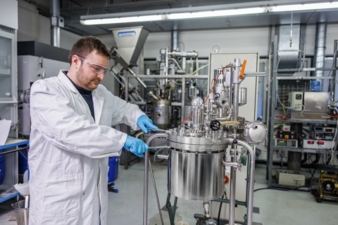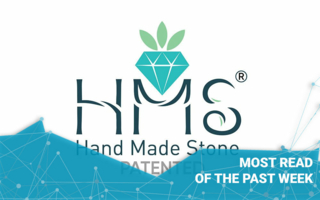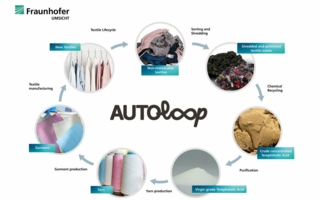20/01/2024 – DITF — auf Deutsch lesen
Carpets – flame retardant and yet recyclable
The German Institutes of Textile and Fiber Research (DITF) and the Institut für Bodensysteme (TFI) have collaborated to develop a concept aimed at enhancing the recyclability of flame-retardant carpets widely used in commercial buildings. The challenge lies in the intricate composition of these carpets, consisting of several interconnected layers, often featuring flame retardants which are ecologically problematic.
Flame-retardant carpet yarn
The innovation involves a carpet yarn utilizing flame-retardant polyamide 6 (PA6) that boasts intrinsic flame retardancy. Unlike conventional methods where flame retardants are applied to the surface, in this approach, a phosphorus compound is chemically bound to the molecular structure of the PA6. This results in a permanent flame retardant that cannot be washed out or emitted into the environment. The concept of intrinsic flame retardancy, developed a decade ago at the DITF, has been refined to meet the challenging requirements of spinnability and high flame retardancy. The new carpet yarn is produced through bicomponent spinning, creating fibers with a core of conventional polyamide and a sheath of flame-retardant PA6.
Cost-effective and eco-friendly
The flame retardant is concentrated on the sheath`s surface, effectively protecting the fiber from flames. Furthermore, this approach reduces production costs by incorporating the flame retardant into only part of the fiber volume. The research project extends beyond the yarn to address carpet production and recyclability. TFI, utilizing polymers and bico-yarns from DITF, is developing a flame-retardant carpet with a modified multifilament yarn top layer and a textile backing. The backing can be thermally separated from the flame-retardant layer, facilitated by hot melt adhesives. The TFI determines the flammability of the textile products. The separability of the top layer and the backing is verified in laboratory tests.
In conclusion, this approach aims to render the production of commercial carpets more cost-effective and environmentally friendly, addressing the challenges of recycling flame-retardant materials in the textile industry.
Scientific contact person:
Dr. Iris Elser
Head of Competence Center “Polymers & Fiber Composites”
T.: +49 (0)711 / 9340-274
E.: iris.elser@ditf.de




